DECLIC
This project (the ultimate aim of which is to develop an integrated model of the economy-climate-cycles system) attempts to answer the following three questions:
- For various levels of stabilization of greenhouse gas concentrations, what will the rate of climate change be, and what will the level be when it stabilizes (in 2100 or later) and in the very long term?
- For each stabilization scenario, what will the compatible emissions of CO2 be towards 2100, and what is the economic plausibility of these scenarios?
- What mitigation strategies should be implemented in order to achieve the emissions associated with the various scenarios?
Several stages of this project will form the basis of a contribution to the fifth report by IPCC working group I, which is due to be published in 2013.

The carbon cycle (NASA)
Objectives
The purpose of this project is to contribute to the next IPCC report (AR5), for which the scientific communities underpinning the three IPCC working groups are to work simultaneously and in a coordinated manner on the development of new scenarios. This implies adopting a new approach to the link between these simulations and the socioeconomic scenarios that underpin their assumptions in terms of net greenhouse gas emissions. This approach allows for a context in which dissociating the concentration scenarios on which climate simulations are based from those used to study emissions reduction policies would hold back the debate on policies for reducing net greenhouse gas emissions discussions. Whether the aim is to study target concentration limits for the 21st or 22nd century or to research the chronological sequencing of policies (in terms of their level and structure), it is important to give proper consideration to the interdependencies between economic growth in each region of the world, biogeochemical cycles of greenhouse gases and their climate feedback, regional impacts of climate change and the net effect of these impacts on economic activity.
- A combination of climate models and carbon models, based on concentration scenarios defined jointly by climatologists and economists, will be used:upstream, to calculate greenhouse gas emission levels compatible with these forecast concentration changes;
- downstream, to assess the corresponding climate change.
This set of simulations will be used by the "climate" community (IPCC working group I, in conjunction with the WCRP and IGBP international climate simulation programmes) and the "impact" community (IPCC working group II, in conjunction with the Impacts, Adaptation and Vulnerabilities consortium (IAV)) to estimate the impact of climate change in the various areas (agriculture, ecosystems, water, health, etc.); they will also be used by economists (IPCC working group III, in conjunction with the Integrated Assessment Models consortium (IAM)) as a basis for devising "political solutions" and assessing the related costs and benefits.
In France, this strategy will be pursued through project DECLIC, which aims to answer the following three major questions:
- For various levels of stabilization of greenhouse gas concentrations, what will the rate of climate change be, and what will the level be when it stabilizes (in 2200 - 2300) and in the very long term?
- For each stabilization scenario, what will the compatible emissions of CO2 be in 2200 - 2300, and how plausible are these emissions scenarios?
- What mitigation strategies should be implemented in order to achieve the emissions associated with the various scenarios?
The analyses will include a coupling of the economy-vegetation-climate system, which represents a major breakthrough compared with earlier research into mitigation strategies such as forest planting, slowing the pace of deforestation and developing the use of biofuels.
Methodology
Part 1: Modelling: development/improvement of existing models
This modelling work will be based on existing tools:
- The Imaclim-R economic model developed by CIRED, which can be used to calculate emissions by each large geographical region based on population growth, wealth accumulation and technological shifts;
- The CLIMBER intermediate-complexity model developed by the Potsdam Institute for Climate Impact Research (PIK) to generate climate simulations incorporating the carbon cycle;
- The Oscar model, also developed by CIRED, which incorporates dynamic land use factors into the carbon cycle. Oscar will be used in conjunction with the Climber model, in order to take into account the climate's impact on the continental carbon cycle, on one hand, and land use-related mitigation strategies (reduction of deforestation, use of biofuels, etc.), on the other;
- IPSL's low resolution 3D model (MGV), based on IPSL's combined global model that incorporates the continental carbon (via ORCHIDEE) and oceanic carbon components (via PISCES). It will be tested on a few stabilization scenarios selected on the basis of the results produced by the lower-resolution Climber model.
Within the context of this modelling research, it appears essential to begin by improving the representation of the carbon cycle in the Climber model, and specifically, by modelling photosynthesis. Doing so will make it possible to determine CO2 emissions for the model (rather than concentrations, as is currently the case) and to perform simulations that, from a configuration forcing perspective, are comparable with the Climber and MGV models.
Furthermore, the models currently only consider carbon dioxide emissions, whereas the trajectories of the other greenhouse gases are determined as concentrations. A module will therefore be developed to calculate the concentrations of the main greenhouse gases other than carbon dioxide (i.e. methane, sulphur dioxide and CFCs) based on their emissions. This module will be based on the simplifying assumption that greenhouse gases have a constant lifetime.
Part 2: Definition of emissions scenarios using Imaclim-R
The challenge in terms of the development of future emissions scenarios is multi-facetted:
- Obtain, as in the past, input data for climate models in order to produce climate forecasts;
- Understand how various socioeconomic scenarios can alter both the pace of climate change and the level at which equilibrium is finally reached in the very long term.
Several scenarios will be defined (together with variants as appropriate):
- A concentration drift scenario in which the main demographic, economic and technical factors responsible for net emissions are set at their highest plausible levels. This scenario will have two variants, corresponding to different rates of deforestation (particularly in tropical regions), which are in turn linked with various assumptions relating to changes in the level and structure of diets and changes in the productivity of farming land.
- A spontaneous concentration stabilization scenario including all of the key factors that might prompt a spontaneous transition to non fossil fuel-based energy systems, whether for reasons of energy security, scarcity of resources, local environmental constraints, or simply due to breakthroughs in "carbon-free" technologies such as solar, nuclear and biomass energy. As before, this scenario will have two variants, corresponding to different rates of change in terms of land use.
- Scenarios involving stabilization at levels of 550 to 800 ppm CO2eq (current level: 385 ppm) based on the hypothesis of prompt action on all levers for limiting net greenhouse gas emissions. These scenarios, which are predicated on a clear political will to act, will enable economists to subsequently analyze the most economically realistic variants in greater detail.
For each stabilization or emissions scenario, the impact of the other greenhouse gases (methane, nitrogen dioxide, etc.) and aerosols will be analyzed. Furthermore, the research team will attempt to identify the mechanisms involved in the drift - and hence the levers of control - of greenhouse gas emissions in the world's large emerging economies and in all developing nations over the course of the 21st century and beyond. To this end, the scientists will systematically examine the driving forces in the emissions scenarios, including assumptions underpinning high-growth scenarios, the future of globalization, infrastructure policies and growth styles, energy systems, and the potential for producing coal-derived liquid fuels and power.
Part 3: Simulations
The following simulations will be carried out, based on a set of emissions scenarios based on the Imaclim-R economic model:
Study of radiative forcing in the 21st century
Transient simulations of the 21st century forced by the carbon dioxide emissions scenarios will be conducted using the Climber/Oscar and MGV models. In particular, they will make it possible to estimate future climate change and continental and oceanic carbon flows, taking climate-carbon feedback into account.
The continental and oceanic carbon flows, together with the increase in atmospheric carbon dioxide will then be used to calculate the annual anthropogenic CO2 emission levels that are compatible with each concentration target. The global emissions thus estimated will then be broken down by region (Australia and New Zealand, North America, Latin America, Europe, Asia, Africa, small islands, and polar regions) and by economic sector (energy, transport, construction, industry, agriculture, forestry, etc.).
The potential for mitigating global warming caused by changing land use (e.g. through reductions in deforestation, biological sequestration and biofuel production) will also be assessed.
Decoupled simulations will be conducted in order to estimate the impact of climate-carbon feedback on the compatible emissions paths and related mitigation strategies; (in this case, the oceanic and continental carbon flows are unaffected by climate change).
Study of climate change at the stabilization horizon (2100 and later) and in the longer term (1000 years)
When the atmospheric greenhouse gas concentration has stabilized, the various components of the Earth System will take some time to return to a state of equilibrium. It is therefore important to study the climate system's transient response during the period of anthropogenic disruption, but also to study the long-term response of the system's slow-responding components, including deep thermohaline circulation, the stability of the polar icecaps and the related change in sea level.
In this context, the team intends to study the following aspects for each emissions scenario:
- Evolution of the polar icecaps over the next millennium, including impacts on sea levels;
- Changes in thermohaline circulation and related climate change, taking into account an additional parameter: the evolution of the polar icecaps. This is because thermohaline circulation depends on the freshwater balance, among other factors, and as such it is sensitive to any melting of the polar icecaps.
Part 4: Climate change feedback on the emissions scenarios
In addition to its impacts on the Earth System, climate change will lead to changes in human behaviour and hence anthropogenic greenhouse gas emissions. For example, we expect to see waves of migrations, changes to energy supply and demand, damage due to extreme climate events, changes in land use, etc. Such events, which have the potential to alter greenhouse gas emissions, are disregarded in current simulations. Within the next two years, when we have a better basic understanding of such feedback effects (thanks to the national and international projects currently in progress), the research team intends to include them in its simulations in order to assess the magnitude of their impacts on emissions scenarios.
Climate change and the carbon cycle
Chapter 7 of the Escrime white paper; Pierre Friedlingstein, Laurent Bopp and Patricia Cadule
Imaclim-R: a modelling framework to simulate sustainable development pathways
Sassi O., Crassous R., Hourcade J.-C., Gitz V., Waisman H., Guivarch C., 2007
IPCC: Intergovernmental Panel on Climate Change
Scenario: Plausible and generally simplified description of the planet's future development, based on a coherent set of assumptions relating to the evolution of the main forces involved in climate change (e.g.: demographics, technology, agriculture, prices, etc.) and the interactions between them. These scenarios are neither predictions nor forecasts.
Intermediate-complexity model : In the context of the climate, this is a model in which the fast-responding components of the Earth System (i.e. the atmosphere and possibly oceans) are represented in a simplified manner in order to be able to include other components (e.g. the polar ice caps and vegetation) and conduct simulations over long periods (>1,000 years).
Thermohaline circulation: Large-scale permanent circulation in the oceans, driven by differences in temperature and salinity.
| CLIMATE |
Philippe CIAIS Laurent BOPP |
| ECONOMICS |
Christophe CASSEN Thierry BRUNELLE |







